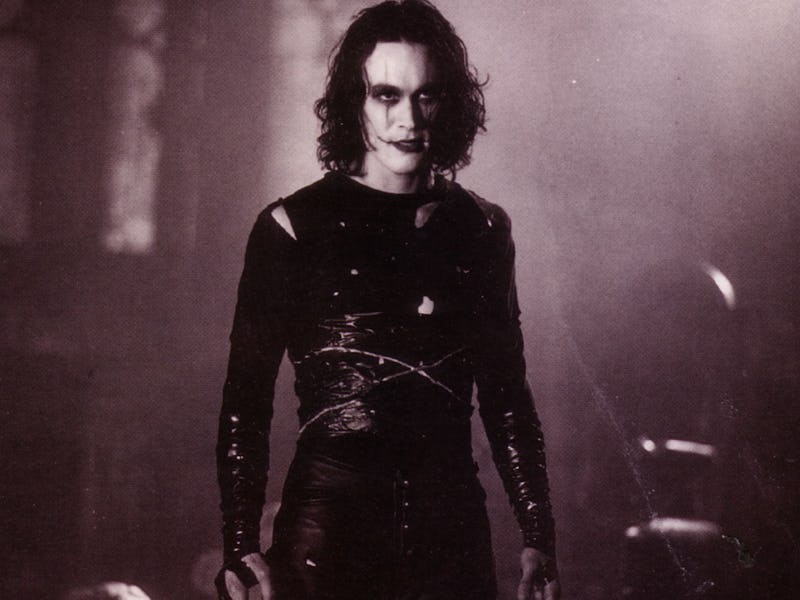With a Remake On Its Way, It’s Time To Look Back at an Iconic ‘90s Superhero Movie
The Crow is a goth masterpiece the likes of which we rarely see.

In the early ‘90s, two seemingly dichotomic trends collided to create one of the most stunning films of the era: The Crow. Both a product of the post-Batman wave of comic book film franchising and the goth/punk rock vibes that evangelized a separation from empty greed, The Crow remains a treat whether you’re looking for a top notch aesthetic, a borderline perfect soundtrack, or an underrated performance from the late Brandon Lee. The upcoming remake (starring Hollywood’s go-to beautiful weirdo Bill Skarsgard) will have a heck of a time trying to surpass it.
Thirty years ago, The Crow emerged during a period of Hollywood reinvention. The success of Batman, a film that had proven to be a bonanza in both the box office and merchandising sales, set off a feeding frenzy. Not only did we get three more Batman films in steady succession throughout the 90s (including Batman Returns, a gorgeous, cynical fairy tale that has a lot in common with the atmosphere of The Crow) but titles like Dick Tracy, Darkman, The Shadow, a couple of Teenage Mutant Ninja Turtles, and even a Fantastic Four movie that never officially saw the light of day. Long before the MCU created what, at the time, looked to be a limitless appetite for the genre, this was the first true superhero movie gold rush.
And though a handful of good titles came out of it, including The Crow, based on James O’Barr’s comic series, it wasn’t hard to see that most of these efforts were spawned from a misguided attempt to seize the lightning-in-a-bottle impact of Batman. A lot of this was an antithesis to the origins of The Crow itself — the series was published by the independent Caliber Comics, a company that certainly gained notoriety, but was far from the household name achieved by the likes of DC and Marvel. Crow himself, originally a young man resurrected by the mystical bird to get revenge on those that brutally raped and murdered his girlfriend, was a prime symbol of its outsider status.
This is the storyline that would be used as the basis for the film, one that found an extraordinary lead in Brandon Lee, son of the iconic Bruce Lee. As Eric Draven aka Crow, Brandon is lithe, brooding and intense, his voice ranging from uncalibrated rage to simmering torment. And while many of his peers had to work around heavy costumes or a lack of training, Lee’s martial arts background made him a natural for the film’s action scenes. It is, in short, a star-making performance.
Helping to power the film was another element that seemed to separate it from the corporate mandated hyper consumerism of the genre (even when packaged in a handy Original Motion Picture Soundtrack): the music. The bands The Crow wrangled together are pretty astounding in retrospect, as they’re all notable members of the alt rock boom period that sought to provide an outlet for Gen X malaise: Stone Temple Pilots, Nine Inch Nails, Rage Against The Machine, etc. “Greed! Causing innocent blood to flow! Entire culture, lost in the overthrow,” Rage sang, embodying the title character’s literally undying resentment against those people and organizations that would prey on others.
Brandon Lee gives a wildly underrated performance in his final film role.
The director of the film, Alex Proyas, was relatively untested in Hollywood at the time and a far cry from names like Tim Burton. His debut feature, Spirits of the Air, Gremlins of the Sea remains both under-seen and underrated. However, it’s immediately clear that Proyas is a master of design and ambiance — The Crow looks and feels fantastic, from the grime of its streets and buildings to the make-up on Lee’s face in one of his passionate close-ups. Proyas, who would go on to direct the even-more-striking Dark City after The Crow’s success, lends his film an undeniable moodiness.
However, the film itself would almost be overshadowed by a tragedy that occurred during its production: Brandon Lee was killed after an accident involving one of the movie’s firearms. The Crow would have to be reshaped to accommodate for what Lee hadn’t filmed yet, but Lee’s powerhouse role still shoulders it all. And with a $94 million box office on a $23 million budget, it’s apparent that audiences felt the same. A string of sequels followed, none of which came close to capturing exactly why The Crow works so well.
Though it certainly fits into the scramble to recreate the Dark Knight’s fame, The Crow is an outlier. Far from the outsized grandness of something like Batman or the increasingly toy friendly antics of the Ninja Turtles or the simple fantasy of Dick Tracy, the Crow leaps across murky rooftops and through cramped alleyways, seeking blood for atonement. He’s trapped in a plan for vengeance that’s more personal than most blockbusters could ever hope to be, and when it’s over, his slain love returns to help him back into his grave. So it isn’t that The Crow is just hard to equal. Perhaps we are never even meant to at all.